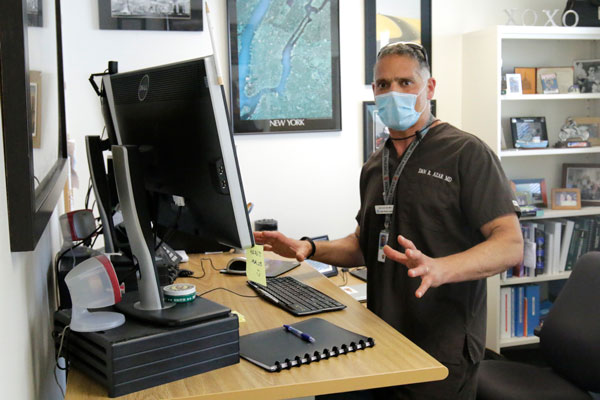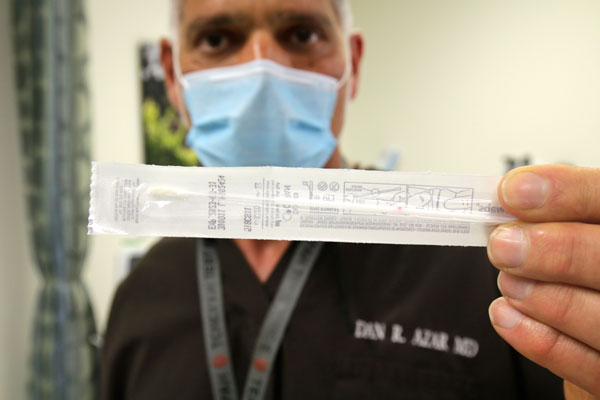Dr. Dan Azar brings training, transparency to COVID-19 response

One of the most consistent voices heard this year during our new reality shaped by the COVID-19 pandemic has been that of Dr. Dan Azar, Sandia’s California site physician.
In the early part of 2020, Dan was part of a panel of medical and scientific experts explaining what little was then known about COVID-19 to members of the Sandia workforce. Then days later, just one week before Alameda County issued shelter-in-place orders, he participated in a panel discussion hosted by Labs Director James S. Peery.
Dan also has been “on call” for almost every coronavirus briefing held by Associate Labs Director Andy McIlroy for the California site and the Integrated Security Solutions Division and has been providing guidance to management and workers on how to safely resume operations. Dan’s understanding of public health and passion for preventive medicine have served him and Sandia well during this pandemic — at a time when keeping people healthy and fulfilling our mission remain our highest priorities.
“I am a naturalized American citizen,” Dan said. “I was born in Israel and brought to the U.S. by my parents when I was 3. My citizenship certificate is framed and proudly hung alongside my medical degree in my Sandia/California office. I was raised in the New York metropolitan area, including Great Neck, Long Island, where I had the privilege of attending an outstanding public high school, which, in addition to my U.S. citizenship, provided me with a lifetime of opportunities.”
These opportunities include dual undergraduate degrees in biology and the biological basis of behavior from the University of Pennsylvania.
“I have always been fascinated by the brain and human behavior, and I’m eager to learn how to help keep people moving in a positive direction,” Dan said. “I came back to New York and attended the Mount Sinai School of Medicine in Manhattan, where I worked as a server and bartender in Greenwich Village until I graduated in 1988.”
Dan then headed back to the West Coast.
“I spent two years at Stanford University Hospital training in anesthesiology,” he said. “But it wasn’t a good match. I wanted to connect with my patients and help them achieve their personal goals.”
Leaving that, Dan began a long career in occupational medicine.
Communication is key
“I saw the injured worker as an occupational athlete who needed my medical skills to get back into the game and my interpersonal skills to help them navigate a complex system,” he said. “I learned to communicate effectively with patients and their employers to address obstacles to recovery, which often included strained relationships between the two. Being a sincere communicator with the intention of serving both parties with integrity and respect turned out to be a place where I really fit in well.”
Dan ultimately earned a master’s degree in public health and became board-certified in occupational medicine. He spent 20 years in private practice in Silicon Valley before joining Lockheed Martin Corp. in Sunnyvale, California, in 2011. In 2017, he was approached by Sandia.
“What appealed to me about both workplaces was the appreciation that lifestyle and prevention are critical to sustaining wellness and resiliency,” Dan said. “Sandia takes this to the next level by providing workers and medical providers with on-site resources, including a health educator, exercise specialist and registered dietitian. On-site Employee Assistance Program counseling and physical therapy round out the nicest clinic staff I have ever worked with.”
Dan had to draw upon all of his expertise and experience in providing medical care and guidance to workers, management and leadership during the COVID-19 pandemic.
“At the onset, we were all caught off guard by how contagious this illness turned out to be,” he said. “We were also confounded by the tremendous variability in severity of illness — with some individuals remaining entirely asymptomatic while others rapidly decompensated and perished.”
Behavioral connection
Dan’s behavioral training has given him a perspective that other physicians may lack.
“Some people found warnings about COVID-19 implausible because a month earlier, they heard we should be more worried about influenza, and now they’re hearing that everyone needs to wear masks all the time,” he said.

“Changing messages can sometimes be perceived as, ‘You don’t know what you’re talking about.’ So, I felt that transparency was really important; we needed to remind people that this disease is something entirely new. In fact, we would be doing a disservice if we didn’t update our message, even though doing so seemed to contradict earlier guidance.”
Dan knew that communication was going to be vital not just in internal messaging but in helping Sandia confront the virus on behalf of the nation.
“As a physician in an organization that’s not centered on health care, it’s important to serve our patients and our customers, including NNSA, the Department of Energy, and the U.S.” he said. “Our foes are looking at this pandemic as an opportunity.”
Dan was part of a broad multicenter team that established Sandia’s on-site clinical collection and analysis of nasopharyngeal specimens to accurately test for the presence of SARS CoV-2, the virus responsible for COVID-19. Dan credits Renee Holland, director of Employee Health Services, and the other team members with developing the testing capability that enabled Sandia to contribute to the national labs complex being able to process more than 1,000 tests per day. That effort recently was submitted for consideration for a DOE Secretary’s Honor Award.
“For Sandia, I wanted to bring — along with Dr. Rick Sauerman, the site occupational medical director in New Mexico — our medical and public health knowledge to leadership meetings so that, as Sandia leaders considered how to safely meet ongoing mission commitments, we could share best practices for preserving the health of our workforce and communities,” he said.
Ensuring a safe return
Dan helped advise Sandia and division leadership on medical messaging, safe return-to-work policies, social distancing and resources needed on campus. Now he and his team are busy with daily coronavirus screenings in the hopes of keeping people from contracting the virus while at work.
Dan said he was struck most this year by how quickly things can change and how resilient his peers across the Sandia worksites have been in the face of these unprecedented events.
“None of us were having this conversation at the end of 2019,” he said. “Our ability to reset when faced with these kinds of challenges is so important. There is no benefit to wishing this thing away. If we work together to expand our knowledge and abilities and make decisions in a way that is transparent to those we serve, we will have the best possible outcome.”